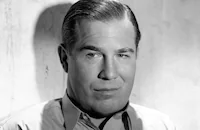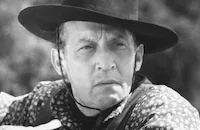Lazy River

Brief Synopsis
Cast & Crew
George B. Seitz
Jean Parker
Robert Young
Ted Healy
Nat Pendleton
C. Henry Gordon
Film Details
Technical Specs

Synopsis
Because they refused to participate in a prison escape, in which a fellow convict, Armand Lescalie, was killed, William "Gabby" Stone and Alfred "Tiny" Smith receive commendations from the Alabama governor and are freed. A few weeks later, Bill Drexel, another reluctant escapee, also is released and tracks his ex-convict friends to a horse stable in New Orleans. Although Bill discourages Gabby and Tiny from pursuing a robbery and horse-betting scheme, he feels no compunction about looking up Miss Minnie, Armand's supposedly rich mother, in a Louisiana shrimping village. When Bill arrives in the small, impoverished Cajun village, he is dismayed to learn from Sarah, Miss Minnie's daughter, that not only is the widowed Miss Minnie not rich, but her shrimping business is on the verge of a hostile takeover by the shrewd half-Chinese smuggler and racketeer, Sam Kee. Before the disappointed Bill leaves the village, however, Tiny and Gabby show up, hungry and pursued, having failed at both their robbery and betting schemes. While Tiny and Gabby search for food, the village is stirred by the arrival of Ambrose, the Lescalies' old friend, whom Miss Minnie had contacted for financial help. After a night of festivities, Ambrose promises to return with the needed money, but is seen leaving by Kee and is killed.
The next morning, as the village sheriff is about to auction off Miss Minnie's business to a cohort of Kee, Tiny spots a safe in Kee's boat and, with Gabby's help, steals enough cash for Bill to buy the business himself. Gabby then pickpockets more money from one of Kee's henchmen, and as her partner, Bill is able to revitalize Miss Minnie's sabotaged shrimping operation. Four weeks later, Bill discovers that he has fallen in love with Sarah and tells her about his troubled life, which includes a disapproving father in Boston and an alcohol-induced marriage to a gold-digging waitress. Sarah is heartbroken by the news and is even more stunned when Ruby, Bill's wife, suddenly arrives in the village. Depressed that Ruby refuses to divorce him, Bill takes a late-night walk on the village pier and is kidnapped by Kee and his men. Gabby and Tiny, however, see Kee rowing Bill to his boat and pursue him in their own rowboat. At the same time, the Coast Guard, suspicious that Kee is using the village to smuggle Chinese refugees in from Mexico, confront Kee's ship with warning gun fire. Before the Coast Guard boards his ship, however, Kee disposes of his illegal cargo by throwing the bound-and-gagged Chinese refugees and Bill overboard. After Tiny executes an underwater rescue of Bill, the three men board Kee's ship and beat and tie up their foes. When Bill returns to shore, he is met by Lodge, his father's lawyer. As a joyful Sarah listens, Lodge informs Bill that his father is anxious for a reconciliation, and that, after he was sent to prison, Ruby had divorced him. Finally free of his past, Bill embraces Sarah.

Director
George B. Seitz
Cast

Jean Parker

Robert Young

Ted Healy

Nat Pendleton

C. Henry Gordon
Ruth Channing

Maude Eburne

Raymond Hatton
Irene Franklin

Joseph Cawthorn
Erville Alderson
George Lewis
Ben Hendricks
Charles Dunbar
Maurice Brierre
Purnell B. Pratt
Chris Pin Martin
Lee Beggs
Bud Fine
Bobby Burns
Walter Long
John Larkin
Lee Shumway

Donald Douglas
Crew
Dr. William Axt
Dr. William Axt
Tod Browning
Clyde De Vinna
Red Golden
James Havens
Robert Hoag
Lucien Hubbard
Lucien Hubbard
William Levanway
Douglas Shearer
William Snyder
William Steinkamp
Gregg Toland
Dolly Tree
Cecil Wright

Film Details
Technical Specs

Articles
Lazy River
By Richard Harland Smith

Lazy River
Quotes
Trivia
Notes
The working titles of this film were Ruby, Dance Hall Daisy, Bride of the Bayou, Louisiana Lou, In Old Louisiana and Louisiana. According to studio records, Lea David Freeman's play was also titled Dance Hall Daisy and is referred to in early news items by that title. Studio records note that the play was purchased in May 1933 and the following writers were assigned to work on the project between March and October 1933: Harry Hervey, Lucien Hubbard, Raymond Schrock, Chandler Sprague, Leon Gordon, Jules Furthman, John Colton, William Faulkner, Erskine Caldwell and Arthur Caesar.
According to studio records, Faulkner arrived in Louisiana on April 26, 1933 to work on the script with Tod Browning, who was the film's original director. However, studio records state: "Faulkner did not do the Basic Material....None of his material on this [film] was ever in Script Dept. files. Perhaps no material was turned in." In a modern interview, Faulkner describes his experience on the production: "I arrived at Mr. Browning's hotel about six p.m. and reported to him. A party was going on. He told me to get a good night's sleep and be ready for an early start in the morning. I asked him about the story. He said, 'Oh, yes. Go to room so and so. That's the continuity writer. He'll tell you what the story is.' I went to the room as directed. The continuity writer was sitting in there alone. I told him who I was and asked him about the story. He said, 'When you have written the dialogue I'll let you see the story.'" After viewing potential locations in Grand Isle sometime later, Browning informed Faulkner that he had been fired by the studio, but before Browning could do anything about it, he was also fired. Although studio records indicate that Faulkner left Louisiana on May 9, 1933, news items suggest that Browning was still directing the project as late as mid-June 1933. According to International Photographer, cinematographer Clyde De Vinna was shooting backgrounds in Louisiana with Browning in June 1933. A mid-July 1933 news item in Motion Picture Herald noted that the film was being shot in the "shrimp camps of Lake Barataria and the land of the Louisiana Cajuns." Joan Crawford, Alice Brady, Lionel Barrymore and Madge Evans were all announced as stars of the picture in various mid-1933 news items.
In January 1934, Hollywood Reporter announced that M-G-M was taking Lazy River "off the shelf." Daily Variety notes that when the project was revived, director George Seitz and producer Hubbard rewrote the story from scratch. It is not known how much of Browning's background footage was used in the final film. Hollywood Reporter news items from January 1934 state that Lupe Velez, Warner Oland and Isabel Jewell were assigned to play parts in the film. None of these actors, however, appears in the finished film. May Robson also was announced as a cast member, but according to Hollywood Reporter, she withdrew from the picture because her part, presumbly that of "Miss Minnie," was too small. According to a March 1934 Hollywood Reporter news item, the film was to have its premiere in New Orleans one week prior to the general release date, but a April 3, 1934 news item in Film Daily suggests that the Louisiana opening May have taken place after the general release.















